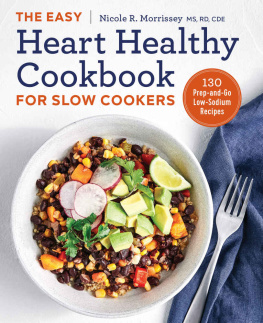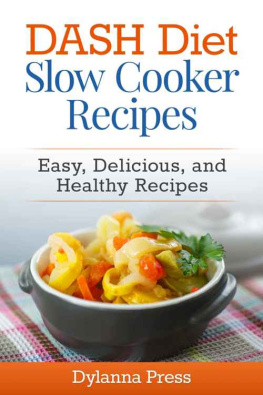15-Minute
Low Sodium Recipes
FAST AND FLAVORFUL LOW-SALT RECIPES
THAT SAVE YOU TIME, KEEP YOU ON TRACK,
AND TASTE DELICIOUS

DICK LOGUE

Contents
INTRODUCTION
Why Another Low-Sodium Cookbook?
S ome of you may be wondering why there is a need for another low-sodium cookbook. If you stop in at your local bookstore or visit an online bookseller, youll see that there are already a number of books on the subject. And a quick search online will reveal a number of websites focusing on low-sodium cooking. Ive contributed to this existing information myself. I have a website at www.lowsodiumcooking.com, and in 2007 I wrote 500 Low-Sodium Recipes. So what made me think that there was a need for another low-sodium book? The main reason was what I hear from people who have visited my website or who are readers of my email newsletter. They tell me that they know they would be healthier if they lowered the amount of sodium in their diet, but its not as easy as it sounds.
In listening to people, I have found there are a couple of recurring themes that seem to be the most common reasons why people find it difficult to stick to a low-sodium diet. And as I thought about my previous books and other low-sodium books that I have collected, it became more obvious that no one has really tried to specifically address these difficulties. The more I thought about it, the more it seemed like a new book might be what was needed.
What Makes Low-Sodium Cooking Difficult?
The reasons people identified seemed to group into a few key areas.
Low-sodium food doesnt taste as good. There is a pretty much widely accepted belief that low-sodium food has no taste, or at least very inferior taste.
Low-sodium cooking costs too much. People believe that because they need to buy ingredients that they havent bought before and that may only be available online, low-sodium cooking is going to be more expensive.
Low-sodium cooking is difficult. The main complaints here are that people dont know where to find low-sodium ingredients or how to make food that tastes good without using high-sodium ingredients.
And the big one...
Low-sodium cooking takes too much time. Everyone is busy these days. There is work, family commitments, and generally busier-than-ever lives. People dont want to spend a lot of their precious time preparing food, so fast food restaurants and convenience foods fill that need, but at the cost of high sodium levels.
How Can We Solve Those Problems?
The purpose of this book is to help people overcome these difficulties and find a way to make the transition to a lower sodium diet easier. Lets take a quick look at how well do that.
Taste. While its true that it does take some time to get used to the taste of food without added salt and high-sodium ingredients, I have heard from a number of people how surprised they were at the taste of the recipes in my first book. But to get to that point does sometimes require being creative, experimenting and tweaking recipes until they taste the way youd like. Many people dont have the time or the desire to do that, so Ive done it for you.
Cost. This is one of the areas where being informed and making smart choices makes all the difference. Yes, its true that you may need to buy some ingredients that you didnt buy before, but you also can make a lot of meals for a lot less money than buying prepared dinners. Instead of spending fifteen dollars for a delivery pizza, you can make one that is healthier, tastes just as good, and costs maybe half that.
Difficulty. There are several keys here. One is knowing which ingredients are available and where to find them. Thats something that has changed a lot since I started my low-sodium diet in 1999. And it has even changed since my first book came out. So its time for an update. The other key here is knowing how to easily make the things you cant readily buy. Ive included a chapter here on make-ahead items that you can just pull off the shelf and use. And that helps to solve...
Time. Theres no way around ityou are going to have to cook more things from scratch to maintain a low-sodium diet. Not as many as in 1999, when I was making my own mustard and ketchup, but its still difficult to find really low-sodium versions of a lot of things, which is where my make-aheads chapter comes in. You will no longer be able to stop at the fast food place or microwave a frozen entre. And that is the real focus of this book. It is filled with 15-minute recipes: main dishes, side dishes, and desserts that you can have on the table in about a quarter of an hour. Theres also a section of recipes that you can prepare in 15 minutes and then let them cook on their own. Many of these involve appliances such as slow cookers and bread machines.
So the bottom line is that you can have tasty, inexpensive, easy, low-sodium meals without spending your life in the kitchen. And that is what people tell me they need in order to successfully transition to a low-sodium diet.
A Little Bit about Me
Some of you may already know me from my Low-Sodium Cooking website and newsletter or from my other books focused on low-sodium and other heart-healthy recipes. For those who dont, perhaps a little background information might be useful.
I started thinking about heart-healthy cooking after being diagnosed with congestive heart failure in 1999. One of the first, and biggest, things I had to deal with was the doctors insistence that I follow a low-sodium diet... 1,200 mg a day or less. At first, like many people, I found it easiest to just avoid the things that had a lot of sodium in them. But I was bored. And I was convinced that there had to be a way to create low-sodium versions of the foods I missed. So I learned all kinds of new cooking things. I researched where to get low-sodium substitutes for the things that I couldnt have anymore, bought cookbooks, and basically redid my whole diet. And I decided to share this information with others who may be in the same position I had been in. I started a website, www.lowsodiumcooking.com, to share recipes and information. I sent out an email newsletter with recipes that now has more than 20,000 subscribers. And I wrote my first book, 500 Low Sodium Recipes.
Perhaps the best way to start in telling you who I am is by telling you who Im not. Im not a doctor. Im not a dietician. Im not a professional chef. What I am is an ordinary person just like you who has some special dietary needs. I have enjoyed cooking most of my life. I guess I started it seriously about the time my mother went back to work when I was twelve or so. In those days, it was simple stuff such as burgers and hot dogs and spaghetti. But the interest stayed. After I married my wife, we got pretty involved in some food-related pursuitsgrowing vegetables in our garden, making bread and other baked goods, canning and jelly making, that kind of thing. She always said that my mad chemist cooking was an outgrowth of the time I spent in college as a chemistry major, and she might be right. So creating the kind of food that people said couldnt be done, low in sodium and high in taste, was a fun challenge for me.
Along the way, I also learned about other things that make a diet heart healthy. I became more aware of cholesterol, fiber, and the glycemic index and began incorporating what we learned into the recipes. So you will find that the recipes here are not only low in sodium, but they also tend to be low in saturated fat, contain whole grains and other high-fiber foods, and tend to focus on fresh ingredients. This all actually comes together nicely, because in many cases the same foods that fit those requirements are also low in sodium and taste better than the less healthy alternatives.








